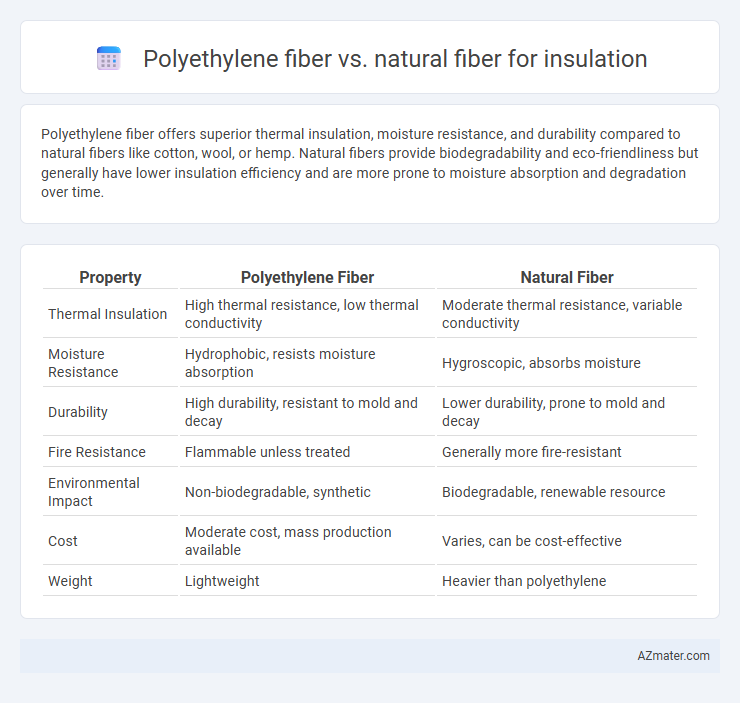Polyethylene fiber offers superior thermal insulation, moisture resistance, and durability compared to natural fibers like cotton, wool, or hemp. Natural fibers provide biodegradability and eco-friendliness but generally have lower insulation efficiency and are more prone to moisture absorption and degradation over time.
Table of Comparison
| Property | Polyethylene Fiber | Natural Fiber |
|---|---|---|
| Thermal Insulation | High thermal resistance, low thermal conductivity | Moderate thermal resistance, variable conductivity |
| Moisture Resistance | Hydrophobic, resists moisture absorption | Hygroscopic, absorbs moisture |
| Durability | High durability, resistant to mold and decay | Lower durability, prone to mold and decay |
| Fire Resistance | Flammable unless treated | Generally more fire-resistant |
| Environmental Impact | Non-biodegradable, synthetic | Biodegradable, renewable resource |
| Cost | Moderate cost, mass production available | Varies, can be cost-effective |
| Weight | Lightweight | Heavier than polyethylene |
Introduction: The Rise of Modern Insulation Materials
Polyethylene fiber insulation offers superior thermal resistance and moisture-wicking properties compared to traditional natural fibers like cotton and wool, contributing to enhanced energy efficiency in modern buildings. Its lightweight and durable structure resists mold and pests, addressing common issues associated with natural fiber insulation. Advances in manufacturing have made polyethylene fibers a cost-effective and sustainable choice for contemporary insulation applications.
Understanding Polyethylene Fiber: Composition and Properties
Polyethylene fiber, composed primarily of long chains of ethylene monomers, exhibits exceptional thermal insulation and moisture resistance compared to natural fibers. Its low density and hydrophobic nature make it highly effective in reducing heat transfer and preventing water absorption, enhancing insulation performance in various applications. Unlike natural fibers such as cotton or wool, polyethylene fiber offers superior durability, chemical resistance, and consistent structural integrity under different environmental conditions.
Natural Fibers Explained: Types and Characteristics
Natural fibers such as cotton, wool, flax, and hemp are widely valued for insulation due to their excellent thermal properties, breathability, and sustainability. These fibers provide effective moisture regulation, natural resistance to mold, and biodegradability, making them an eco-friendly alternative to synthetic options like polyethylene fibers. Their cellular structure traps air, enhancing insulation performance while maintaining comfort and reducing environmental impact.
Thermal Performance: Comparing Insulation Efficiency
Polyethylene fiber insulation exhibits superior thermal performance due to its low thermal conductivity, typically around 0.03-0.04 W/m*K, which effectively minimizes heat transfer. In comparison, natural fibers such as wool, cotton, or hemp have higher thermal conductivities ranging from 0.04 to 0.06 W/m*K, resulting in moderate insulation efficiency. The synthetic structure of polyethylene fibers allows for better moisture resistance and consistent thermal properties, enhancing overall energy-saving capabilities in insulation applications.
Moisture Resistance: How Each Fiber Handles Humidity
Polyethylene fiber exhibits superior moisture resistance due to its hydrophobic properties, preventing water absorption and maintaining insulation performance in high-humidity environments. Natural fibers, such as cotton or wool, tend to absorb moisture, which can lead to reduced thermal efficiency, increased weight, and potential mold growth. The moisture-wicking capability of natural fibers may provide some breathability, but polyethylene fiber remains more effective for long-term insulation durability in damp conditions.
Environmental Impact: Sustainability and Biodegradability
Polyethylene fiber insulation offers superior durability and moisture resistance but relies on non-renewable petroleum resources, resulting in a higher carbon footprint and limited biodegradability. Natural fiber insulation, sourced from renewable materials like cotton, wool, or hemp, boasts lower embodied energy and is biodegradable, promoting enhanced sustainability and reduced landfill waste. Choosing natural fibers supports eco-friendly building practices by minimizing environmental impact through biodegradability and sustainable harvesting.
Health and Safety Considerations in Insulation Choices
Polyethylene fiber insulation offers superior resistance to moisture, mold, and pests, reducing health risks associated with allergens and respiratory issues compared to natural fibers like wool or cotton, which may harbor mold or attract insects. Natural fibers are biodegradable and less chemically processed, minimizing exposure to synthetic compounds but may require chemical treatments that introduce irritants or VOCs, impacting indoor air quality. Selecting insulation requires evaluating potential exposure to dust, irritants, and microbial growth, prioritizing materials that balance safety, sustainability, and durability for optimal indoor environmental health.
Installation and Handling: Ease of Use and Durability
Polyethylene fiber insulation offers superior ease of installation due to its lightweight, flexible nature, and resistance to moisture, reducing the risk of mold and degradation during handling. Natural fiber insulation, such as cotton or wool, requires more careful handling to avoid damage and often necessitates protective treatments to enhance durability and resistance to pests. The durability of polyethylene fiber under varying environmental conditions typically exceeds that of natural fibers, providing long-term performance with minimal maintenance.
Cost Analysis: Affordability and Long-Term Value
Polyethylene fiber insulation offers a lower initial cost compared to natural fiber options such as wool or cotton, making it a more affordable choice for large-scale projects. Its durability and resistance to moisture and pests contribute to a longer lifespan, reducing replacement and maintenance expenses over time. Conversely, natural fibers often incur higher upfront costs but provide environmental benefits, which may appeal to eco-conscious consumers despite potential durability trade-offs.
Conclusion: Choosing the Right Fiber for Your Insulation Needs
Polyethylene fiber offers superior moisture resistance, durability, and thermal insulation compared to natural fibers such as cotton or wool, making it ideal for environments prone to humidity or wear. Natural fibers provide excellent breathability and sustainability, appealing for eco-friendly insulation solutions where environmental impact is a priority. Selecting the right fiber depends on balancing performance requirements with ecological considerations and specific insulation conditions.

Infographic: Polyethylene fiber vs Natural fiber for Insulation
 azmater.com
azmater.com